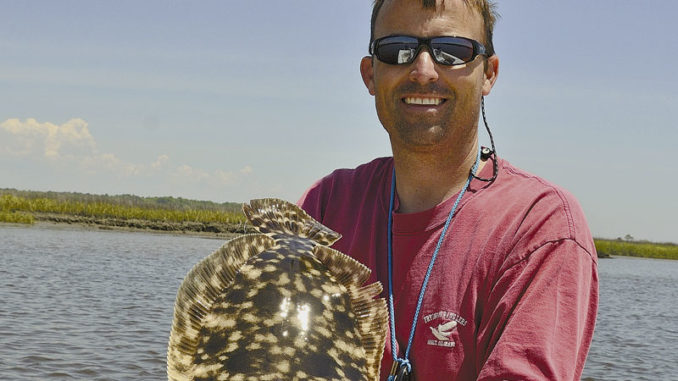
Little River and Bulls Bay, two very different estuaries, provide South Carolina fishermen great opportunities this month as inshore waters fill up with hungry flatfish.
South Carolina is known for many things, but for fishermen and fish-eaters, it’s the excellent fishing in both freshwater and saltwater environs. And the No. 1 culinary delight is the flaky, white flesh of the flounder.
South Carolina’s inshore waters contain prime habitat for flounder. And some zip codes offer a better opportunity to connect with them as spring gives way to summer this month.
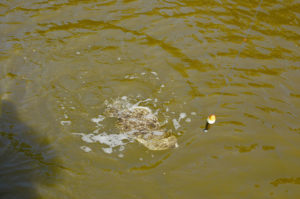
From Little River along the North Carolina border to the mouth of the Savannah River along the Georgia border, flounder can be caught most days from nearshore reefs to the westernmost reaches of the freshwater-saltwater dividing line.
Flounder flood inshore waters by summer
Some flounder overwinter in inshore waters. But most move to greener pastures when conditions aren’t favorable to their needs. They experience seasonal migrations in and out of the estuaries based on weather and environmental factors. But late in spring, inshore waters erupt with flounder.
Beginning in late March, waves of flounder show up at the inlets and in the estuaries when the first few rounds of migratory baitfish arrive. As the waters continue to warm with spring’s arrival, more and more slide into the estuaries to feast on the abundant forage. When June appears on the horizon, the annual migration into the estuaries is essentially over, and inshore waters are chocked full of these flatties.
These flatfish can be found in most inshore waters this time of year. But some places provide a better chance to consistently land them on a routine basis. These two are some of the better-known places that provide anglers with a good shot at connecting with these flat, tasty beasts.
Little River Area
The waters around Little River along the North Carolina/South Carolina border are excellent places to consistently catch doormat flounder. Just make sure you stay on the south side of the state line. Flounder fishing in North Carolina is closed until mid-August.
Brandon Huskins of Any Tide Fishing Charters fishes out of a shallow-draft skiff to tackle many of the best flounder habitats in this area, from the skinny backcountry to the jetties along the ocean’s margin.
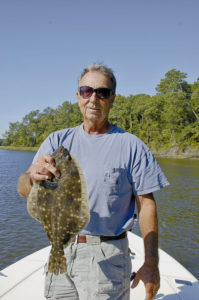
“Our flounder fishery is going to be hard pressed to beat. Cherry Grove, Tubbs Inlet, Little River Inlet and the ICW are all flounder hotspots,” said Huskins (843-877-7068). “Flounder associate with structure. And we have so much great structure here in different habitats from waterway docks, oyster creeks, and drainages close to flats they love to be in.”
Huskins fishes all of these areas in June. But he concentrates on docks along the ICW on higher water for the biggest fish. The ICW in the Little River area receives a strong influx of nutrient-rich water from the Waccamaw River to the south. The Little River swing bridge is the saltwater-freshwater dividing line. That’s where the nutrient-rich freshwater flow meets the saltwater, creating plenty of feeding opportunities for baitfish.
Try artificial shrimp for added fun
This area is littered with docks and marinas, making for feeding opportunities for flounder and other predators. It has some oysters and rock piles along its floor. But the majority of the ICW in this area contains clean bottom. And that offers a perfect place for flounder to set up and ambush bait around man-made structures.
Huskins loves these waters for flounder, using live finger mullet or mud minnows on Carolina rigs. When the tide turns around and begins to fall, he will often shift to creek mouths in front of oyster beds.
“Flounder will stage up along creek mouths to catch mullet and other baitfish flushing out of these creeks and flats,” he said.
Huskins likes live bait. But his favorite way to target flounder is with artificial shrimp.
“I like to drift with the tide along the narrow creeks and channels, bouncing Vudu Shrimp along the bottom,” he said. “You don’t miss as many fish with the shrimp. And you can also cover a lot of ground by using artificial lures. Flounder will not turn down a shrimp fluttering along the bottom, either.”
Double it up for flounder
One of Huskins’ secrets for increasing his chances for a hook-up is a double-rig.
“My secret for catching flounder all year-long is my tandem-rigged bait. I rig two of the same lures on fluorocarbon line staggered 3 or 4 inches apart,” he said. “When the first comes across, it gets their attention, and then they will hit the second one as it appears in front of them. You can cover a lot of ground fast, and you will get more strikes and put more fish in the boat by using this method.”
 Bulls Bay/Cape Romain Area
Bulls Bay/Cape Romain Area
The Cape Romain/Bulls Bay area is between Georgetown and Charleston, an area very unique to South Carolina and the entire coast. Its interior estuaries are massive shallows that connect to the Atlantic Ocean. This region provides a primary nursery area for a huge collection of baitfish and gamefish. And it creates a primary feeding center for lots of predators, including speckled trout, redfish, tripletail, tarpon, sharks, sheepshead and doormat flounder.
Rob Beglin of Inshore Xtreme Fishing Charters lives in Pawleys Island but primarily runs his charters out to the Cape Romain/Bulls Bay area.
“This estuary is so much different than anywhere else around here because of the marsh layout and the abundance of shallow water, muddy bottom and shell,” said Beglin (843-458-1920). “Most of this estuary is shallow, and it can be treacherous for a novice to the area. But it really can hold a lot of fish.”
The flounder bite picks up in May and peaks in June for Beglin, who utilizes the same tactics for flounder that he does for redfish.
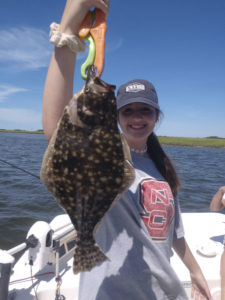
Spinnerbaits catch flounder too
“They will often be set up in the same locations and taking advantage of the same conditions,” he said. “We catch just as many flounder as reds on many days.”
Since the estuary is broad and shallow, the falling tide is Beglin’s favorite time to fish because bait and flounder get bunched together in the same areas. The smaller channels and creek mouths adjacent to structure are perfect places to find these fish.
“They don’t have any other choice but to sit either in the center of the creek mouth or just outside it,” he said.
Beglin believes there’s no better lure for flounder than a spinnerbait with a No. 4 gold Colorado blade and a 4-inch Gulp swimming mullet trailer.
“I slow-roll the spinnerbait along the bottom, and they can’t stand it,” he said.
Since flounder rely heavily on their eyesight for feeding, clear water is a bonus. And the wind can have a dramatic effect on the fishing conditions in the Cape Romain/Bulls Bay estuaries. Beglin likes a south to southeast wind because it keeps water in the bay and usually makes for good visibility.
“A southwest wind will blow the water out, and anything from the north will muddy the water up so much you can’t see 3 inches in the water. The south to southeast wind is the best option for fishing this area,” he said.

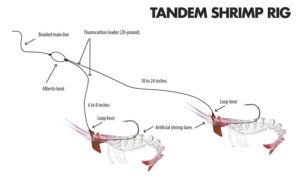
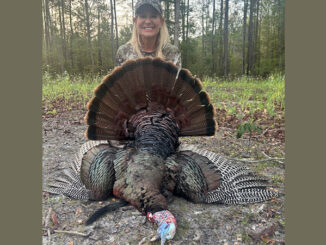

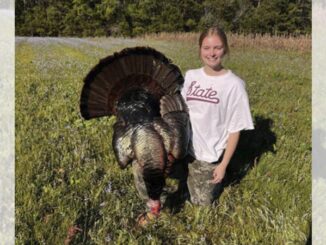

Be the first to comment